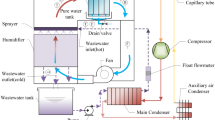Abstract
Oxidation ditch process is used to treat the municipal and domestic sewage. The untreated sewage generates fouling smell, harmful bacteria, etc. which is hazardous for public health and degrades the environment by librating noxious gases. This paper examines the use of curved blade aerator for oxidation ditch process. The rotor, which controls the aeration, is the main component of the aeration process. Therefore, the objective of this study is to find out the variations in overall oxygen transfer coefficient and aeration efficiency for different configurations of aerators by varying the parameters like speed of aerator, depth of immersion and blade tip angles so as to yield higher values of overall oxygen transfer coefficient and aeration efficiency. Four aerators of different configuration were developed and fabricated in the laboratory and were tested for above mentioned parameters. A mathematical model is developed for predicting the values of kLa and aeration efficiency which has R2 values of 0.97 and 0.99 for experimentally determined and calculated values. In laboratory studies, the optimum value of overall oxygen transfer coefficient and aeration efficiency were observed to be 10.33/hand 2.269 kg O2/kWh for aerator speed of 48 rpm, 5.5 cm depth of immersion and 47° blade tip angle for curved blade aerator.
Similar content being viewed by others
References
Abusam, A.; Keesman, K. J.; Meinema, K.; Straten, G. V., (2001). Oxygen transfer rate estimation in oxidation ditches from clean water measurement. water Res., 35(8), 2058–2064.
Abusam, A.; Keesman, K. J.; Spanjers, H.; Meinema, K. (2002). Evaluation of control strategies using an oxidation ditch benchmark., water. Sci. Tech., 45(4–5), 151–158.
APHA, (1980).Standard methods for the examination of water and wastewater, 15th. (Ed.), America Public Health Association, America Water Works Association, and Water Pollution Control Federation, Washington D.C.
Ahmad, T.; Boyd, C. E., (1988). Design and performance of paddle wheel aerators., Aquacult. Eng., 7(1), 39–62.
ASCE standard (1997).Standard guidelines for in-process oxygen transfer testing. The American Society of Civil Engineers, 18–96, New York.
Boyd, C. E., (1998). Pond water aeration systems., Aquacult. Eng. 18(1), 9–40.
Boyd, C. E.; Watten, B. J., (1989). Aeration systems in Aquacultural., Crit. Rev. Aquacult. Sci., 1(3), 425–472.
Busch, C. D.; Koon, J. L.; Allison, R., (1974). Aeration, water quality and catfish production., T. Am. Soc. Agr. Eng., 17(3), 433–435.
Cancino, B., (2004). Design of high efficiency surface aerators part 2. Rating of surface aerator rotors., Aquacult. Eng., 31(1-2), 99–115.
Colt, J., (2000a). Design of gas transfer systems for aquaculture, part 2., Aquacult. Mag., 26(5), 50–55.
Colt, J., (2000b). Design of gas transfer systems for aquaculture, part 3., Aquacult. Mag., 26(6), 53–59.
Dudley, J., (1995). Process testing of aerators in oxidation ditches., Water Res., 29(9), 2217–2219.
Elliott, J. W., (1969). The oxygen requirements of Chinook salmon., Prog. Fish Cult., 31(2), 67–73.
Gillot, S.; Heduit, A. (2000). Effect of air flow rate on oxygen transfer in an oxidation ditch equipped with fine bubble diffusers and slow speed mixers.,, 34(5), 1756–1762.
Horvath, I., (1984).Modeling in the technology of waste water treatment, Pergamon, Tarrytown, NewYork.
Kumaran, P. (1992). Performance evaluation of an oxidation ditch for phenolic wastewater treatment., Indian J. Environ. Health., 34(4), 308–317.
Metcalf and Eddy Inc. (2001). Treatment disposal and reuse. Tata McGraw Hill. New Delhi, India. American Public Health Association.
Moulick, S.; Mal, B. C.; Bandyopadhyay, S., (2002). Prediction of aeration performance of paddle wheel aerators., Aquacult. Eng. 25(4), 217–237.
Moulick, S.; Mal, B. C.; Bandyopadhyay, S., (2005). Design characteristics of single hub paddle aerator., J. Environ. Eng. 131(8), 1147–1154.
Mueller, J.; Boyle, W. C.; Ing, H.; Popel, J., (2002). Aeration: Principles and practice No. 11., Water quality management library.
Nakasone, H.; Ozaki, M., (1995). Oxidation-ditch process using falling water as aerator., J. Environ. Eng., 121(2), 132–139.
Ognean, T., (1993). Aspects concerning scale-up criteria for surface aerators., Water Res. 27(3), 477–484.
Rao, A. R., (1999). Predication rate in square, stirred tanks., J. Environ. Eng. 125(3), 215–223.
Rao, A. R.; Kumar, B., (2007). Neural modeling of square surface aerators., J. Environ. Eng. 133(4), 411–418.
Schmidtke, N. W.; Horwath, T., (1977). Scale-up methodology for surface aerated reaerators., Prog. Water Tech. 9, 477–493.
Simha, L. U., (1991). Experimental studies on overall oxygen transfer coefficient., Ph.D thesis. Departement of Civil Eng., Indian institute of science, Bangalore, India.
Stukenberg. J. R.; Wahbeh, V. N.; McKinney, R. E., (1977). Experiences in evaluating and specifying aeration equipments., J. WPCF. 66–82
Wesner, G. M.; Ewing, J. J.; Lineck, T. S.; Hinrichs, D. J., (1977). Energy conservation in municipal wastewater treatment., EPA-130/9-77-011, NTIS No. PB81-165391,U.S. EPA Res., Washington, D.C.
Zlokarnik, M., (1979). Scale up of surface aerators for waste water treatment., Adv. Biochem. Eng. 11, 157–179.
Author information
Authors and Affiliations
Corresponding author
Rights and permissions
About this article
Cite this article
Thakre, S.B., Bhuyar, L.B. & Deshmukh, S.J. Oxidation ditch process using curved blade rotor as aerator. Int. J. Environ. Sci. Technol. 6, 113–122 (2009). https://doi.org/10.1007/BF03326065
Received:
Revised:
Accepted:
Published:
Issue Date:
DOI: https://doi.org/10.1007/BF03326065




